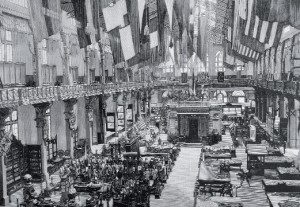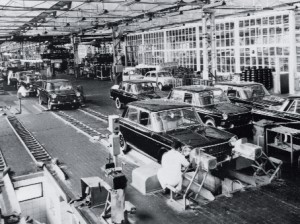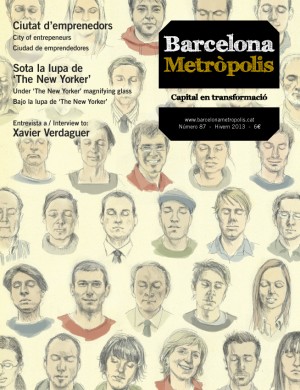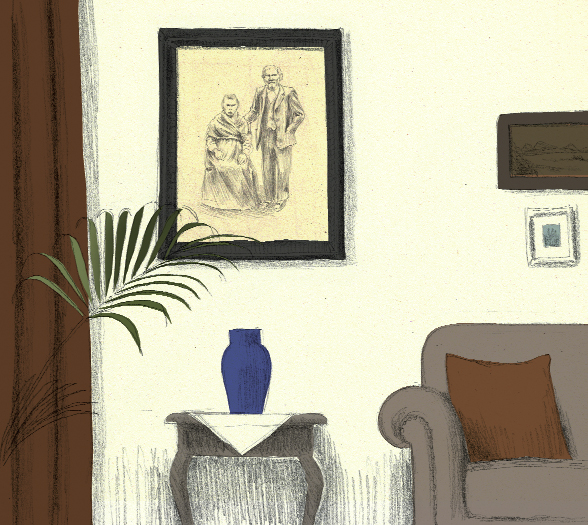In Barcelona, and throughout Catalonia, the so-called social ladder has historically prevailed, due to the absence of major landowners and the progressive emergence of middle classes. Newcomers were just as likely to make their fortune as the traditional bourgeois families. In this regard, there is also a sharp contrast with other cities in Spain.
Before his death, King Charles V of Spain (1500–1558) is reputed to have given the following advice to his heir, the future Philip II: “If you want to keep your empire, make Barcelona its capital; if you want to make it great, put it in Lisbon; if you want to lose it, put it in Madrid.” His words made a lot of sense. The Spanish empire – European and American – had no standing capital at the time. Barcelona represented the Mediterranean Sea and the Old World; Lisbon represented the American continent, the New World to which, centuries later, the Czech composer Dvo?ák would dedicate his Ninth Symphony; Madrid was an isolated city in the heart of the Iberian Peninsula. Philip ignored his father’s advice and established his permanent capital in Madrid in 1561. Difficult overland communications made it a capital alien to trade, until aeroplanes, motorways and high-speed trains did away with its isolation in the second half of the 20th century.
Barcelona, a Mediterranean city, has an age-old commercial tradition. Trade involves the exchange of goods but also of people and knowledge, hence it is a core activity for economic development. Historically, the natural trade routes were the seas and navigable rivers. Moreover, Barcelona was the capital of Catalonia, a region that was closely linked to France and Europe. The Pyrenees do not constitute an insurmountable barrier for Catalans, as the central section of this mountain range does, so natural maritime trade by a country with hundreds of kilometres of coastline was increased by overland trade. The people of Barcelona, and Catalans in general, were great travellers and knew Europe well, just as much, or even more so, than the American colonies of the Spanish Empire.
This geographical explanation is crucial in understanding the phenomenon of industrialisation that began in the first three decades of the 19th century. Barcelona would be the capital of the only country in southern Europe to create an industrial fabric, just a few years behind Great Britain and the other pioneering countries in Europe. Trade and industry were closely bound to an entrepreneurial spirit, typical of Catalonia, which was to become patent in Barcelona, the capital and focal point of most projects.
The 19th century was the century of technological breakthroughs, linked to industrialisation. All the technological advances made in that century reached Spain via Barcelona: the steam engine, the railroad, the telegraph, the telephone and electricity. The same was true of changes in the financial sector: the Bank of Barcelona (1844) was the state’s first modern bank, and the Barcelona Stock Exchange was the first to create a stock market where company securities were traded, while the Madrid Stock Exchange was organised around public debt. Initiative in Barcelona and Catalonia was basically in the private sector, since the public sector was barely relevant. Foreign investment was ploughed into the exploitation of Spain’s major mineral resources and the construction of railways on the Iberian Peninsula, whereas Catalonia – lacking any natural resources of substance – funded railways and factories with its own resources.
Industrial espionage
In the early 19th century, Barcelona’s Board of Commerce, then the business owners’ association, dispatched a spy – with all expenses paid – to the region of Mulhouse, Basel and southern Germany. He worked as a labourer in the area’s factories and copied the machines and learnt the industrial processes. The French police eventually got wise to him and he hurried back to Barcelona, where he published two big books of plans and drawings. It was a very unadvisable procedure, although it did secure – and fairly cheaply for that matter – the progress made by the French, Swiss and Germans in the textile and chemical sectors. It is reminiscent of the system used by some Japanese industrialists after the Second World War. In any case, 200 years on, it is proof of the spirit of the city’s entrepreneurs, who were keenly tuned in to what was afoot in Europe and who were willing to follow – and copy – its path to economic development.

© Prisma
Central gallery of the Palace of Industry at the 1888 Universal Exposition, in an engraving taken from La Ilustración Española y Americana.
Barcelona’s 19th-century entrepreneurs were fully aware that change lay abroad, and that it would bring a revolution with it, in the economic sense of the word that is to say, social change. In the Barcelona newspapers and magazines of the day, the most oft-repeated word in opinion articles was “progress”. And that progress was abroad: in Paris, London, Frankfurt, Milan, Chicago and Philadelphia, which is where Catalans went. However, by 1888 they felt equal to the task of holding the Universal Exposition, where they showed outsiders that they had learnt the lesson of the new technologies and showed the world that they could get things right. The experience was repeated in 1929, with the International Exposition. Thus, Barcelona took its place alongside the major enterprising cities of Europe and America.
The city’s geographical location worked to its advantage again in 1869, when the Suez Canal was opened after being built by Ferdinand de Lesseps, who had been French consul in Barcelona for many years. The Mediterranean was no longer a dead end but rather a gateway for ships inbound from Asia and for outbound European vessels.
The city of Barcelona cannot be understood without the Catalan hinterland and its successive waves of immigration, all of them linked to the employment provided by industrialisation and the emergence of service companies. Over the course of the 19th century, immigrants came mainly from other parts of Catalonia, a trend that continued into the early years of the 20th century, attracted by the work available through the International Exposition. Subsequently, between 1940 and 1970, the source of immigration was the rest of the Spanish state, as people flocked from the large, impoverished rural areas to seek employment in Barcelona and its catchment area. Finally, at the end of the 20th century, highly diversified immigrants from developing countries arrived. A new population, but one which quickly emulated the industrious spirit of the city and its surrounds.
Very high social mobility
Fortunately, in Barcelona and throughout Catalonia, the so-called social ladder has historically prevailed, due to the absence of major landowners and the progressive emergence of middle classes, soon to be the majority. Newcomers were just as likely to make their fortune as the traditional bourgeois families. Historically, social mobility has been very high. In this regard there is also a sharp contrast with other cities in Spain, where the bourgeoisie is more consolidated. In Barcelona there is an economic middle class which changes over the years. Some people move up the ladder while others descend.
Unfortunately, dictatorial regimes spanned almost half of the 20th century. First of all, there was Primo de Rivera’s dictatorship (1923–1930), followed by Franco’s (1939–1975), with a three-year civil war in between (1936–1939). Evidently, Spain stayed out of the two World Wars. However, not only did the dictatorial regimes violate people’s basic rights, they also jeopardised Barcelona’s economic development and its businesses. Primo de Rivera’s regime, with heavy public sector interventionism, nipped private initiative in the bud. From this standpoint, Franco’s protracted dictatorship may be split into two clearly different periods. Between 1939 and 1959, the economic policy of the Spanish government was characterised by its irrationality – autarky – and by the incompetence of the economic ministers. From 1959 until Franco’s death in 1975, the so-called technocrat ministers brought a certain degree of rationality to economic policy and promoted a process of deregulation which, although slow, did permit relative development.

© Prisma
Final inspection of a SEAT 1500 on the assembly line at the company’s factory in the Free Zone, in the 1960s.
After two and a half years of transition, and with the advent of democracy, in 1978 Barcelona and Catalonia witnessed a phenomenon which those of us who experienced it would never have even dared to imagine. The economy went from being a protected and restrictive system to an open one competing with everyone and everywhere. This became particularly true in 1986, when Spain joined the European Union. The traditional Catalan textile industry, leader for over 100 years, collapsed almost in its entirety, as did other sectors of industry which were not in a position to cope with an open market. Nevertheless, the enterprising citizens of Barcelona did not take long to adapt to the new conditions. Industry, which some years previously had embarked upon a process of diversification, accentuated this process, and at the same time embraced the new and technologically advanced service companies. The industrial sector created what would be dubbed “pocket multinationals”: small- and medium-sized enterprises that work for a world market, offering a different and competitive product in terms of quality and price. There are hundreds of such small multinationals with production facilities outside Barcelona and Spain. Exports of products by companies based mainly in Barcelona account for some 28% of exports from the whole of Spain.
It was not easy to get the 1992 Olympic Games, among other reasons because the city, due to the size of its population, did not seem to fit the bill. The committee that championed its candidature had to explain the historical reality of the city and its metropolitan area to the visiting representatives of the Olympic Committee. The figure of 1.7 million inhabitants was under the threshold required of cities that want to host the Games. And the fact is that Barcelona, unlike Madrid or other large cities, has respected the autonomy of its neighbouring towns. The Plain of Barcelona is inhabited by more than 3 million people, with no apparent sign of them belonging to a given municipality, and with a continuum of buildings and streets. In any event, the Olympics gave the Barcelona brand a strong boost as a city for business, industry, tourism and services.
The city’s enterprising nature is endorsed by the presence of Spain’s leading and most important business schools. The IESE and the ESADE, established in 1958, are acknowledged as being among the best in the world for their quality teaching.
Catalans who were not from Barcelona used to say “Barcelona is good if you have money in your pocket”, which was meant to suggest that the city offered more to people with money. However, the locals reworded the saying: “Whether or not you have money in your pocket, Barcelona is always good”. They were right, as it is a land of opportunities.





Un article molt bó, m’ha agradat força. És un petit resum de la història de la Barcelona dels darrers dos-cents anys.